Menu
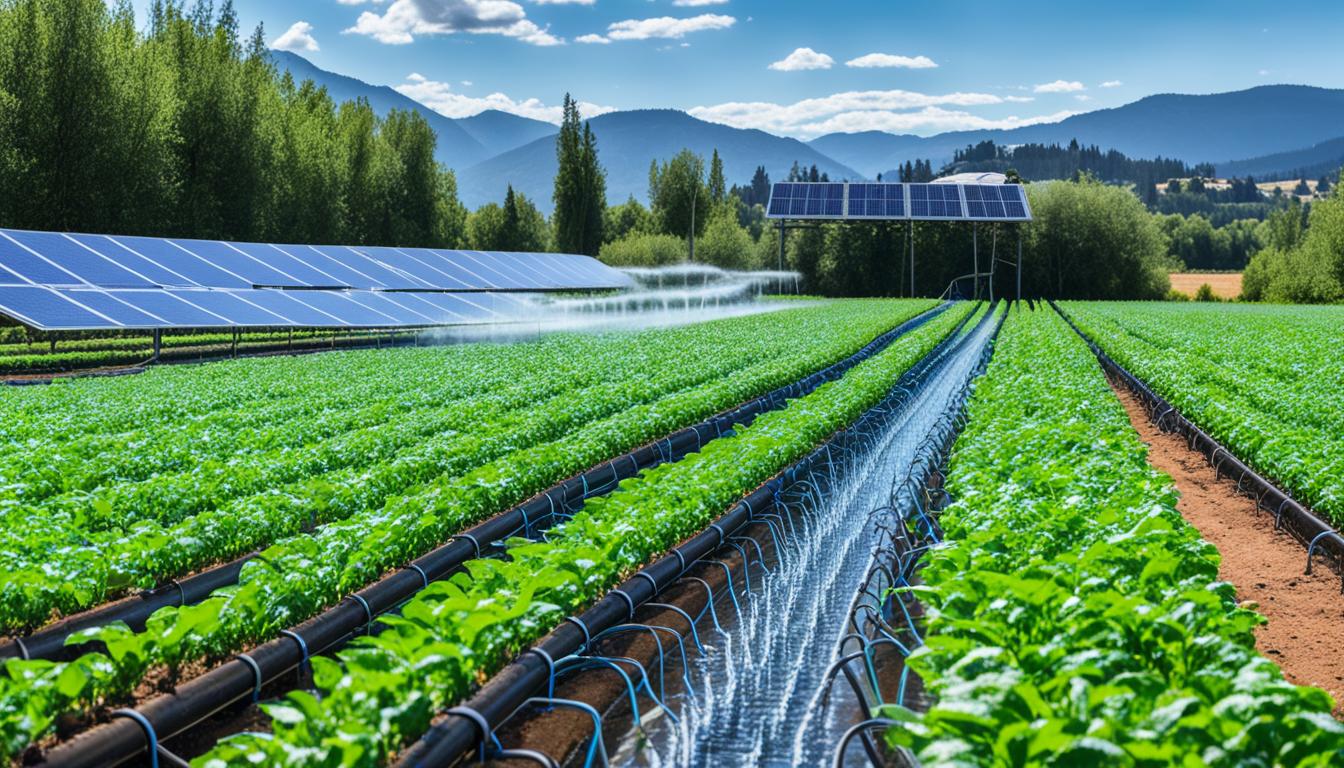
Adopting automated irrigation systems can cut labour costs by about 30%. This stat is just the start. By using electronic and mechanical parts, these systems offer a smart watering solution. It adjusts watering precisely for different plants. This saves water, boosts crop yields, and keeps landscapes healthy. Also, they help in saving water and suit changing weather, improving farming.
Automated irrigation systems make watering easy for gardens, landscapes, and farms. They use automated moisture control to water plants just right. This avoids too much or too little water. Advanced technology in these systems saves water, time, and stops manual watering.
But, setting these systems up can be expensive. They need careful installation and regular checks. This avoids problems like not working right due to mistakes.
Types of Automated Irrigation Systems
Each system has its place, from small channels to large fields. They all have their own benefits.
Factors to Consider
It’s important to look carefully at different systems. They all have their own good and bad points.
Study Insights
From June 11 to July 27, 2021, soil sensors showed dry conditions on July 19. The IoT system made precise watering possible. It checked soil moisture and set the system to water only where needed. This saved water and helped crops grow better.
System Layouts and Automation Techniques
Technological Advancements
Simple methods work well in dry areas, like clay pots. High-tech systems save energy. They vary in price, from cheap timers to complex setups that need a lot of care.
Experts are needed to keep these systems running smoothly. This means avoiding problems with the technology.
Automated irrigation systems have many advantages. They’re designed to use water wisely. This saves a lot of water. They do this by watering only the right places at the right times.
These systems save on costs and time. Manual watering becomes unnecessary. This means less work and less money spent on people and vehicles used for watering.
Plants get the water they need when they need it. This helps manage watering for many plants efficiently.
There are different kinds of these systems. They include pneumatic, portable, and SCADA systems. This means there are solutions for all sorts of farms and gardens.
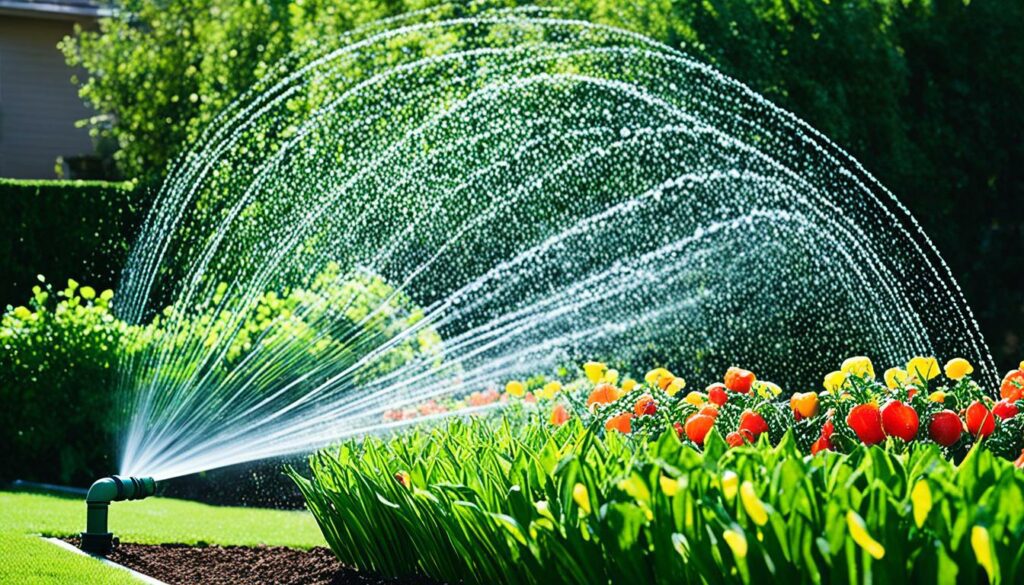
Before getting an automatic system, there are a few things to think about. Initial costs are high. And there might be errors at the start. But, with good planning, these systems can greatly improve how water is used.
Once set up, these systems make sure water is perfectly spread. This cuts down on water waste. It also helps plants grow stronger while using less water.
For both homes and farms, these systems have many pluses. They improve how water is used, keep plants healthy, and even add value to properties.
Looking at what companies like Sposato Irrigation offer is smart. They have modern, cost-effective solutions. Investing in this tech means better and more responsible use of water.
| Aspect | Automatic Irrigation System | Manual Irrigation |
|---|---|---|
| Labour Requirement | Low | High |
| Water Efficiency | Optimal | Variable |
| Initial Investment | High | Low |
| Reliability | High (with proper setup) | Subject to human error |
Automated irrigation systems are changing how we use water in farming and gardening. They use advanced technology to manage soil moisture and apply water precisely. Let’s look at the main parts that make these systems work well.
The Arduino Uno board acts as the system’s central command. It’s programmed to run the irrigation system. This board works with sensors to set watering schedules and smart watering plans.
Soil moisture sensors are key to keeping the right balance in soil moisture. At Penn State’s Fruit Research Centre, they used special sensors to watch soil moisture levels. This data is sent to the Arduino. This way, water is only used when the soil needs it.
Relay modules are like the system’s traffic lights, managing water flow. In the IoT project at the Research Centre, these relays were critical. They made sure water was delivered automatically, according to the moisture levels in the soil.
Drip irrigation parts, like tubes, emitters, and connectors, work to water plants directly at the roots. This precise watering supports the plants better. It helps plants grow stronger and saves water too.
Creating an automatic watering system needs smart thinking and careful choices. It should make sure water is used well. Using new tech and green methods, we can make a strong, working system.
Getting the layout right is key to a good watering system. We place sensors, irrigation lines, and drip emitters perfectly. This makes sure all parts get enough water, with no waste. Drip systems are great because they give water straight to plants at the roots. They use little water this way. Smart controllers also help. They check the weather and adjust water use. This makes the system even better.
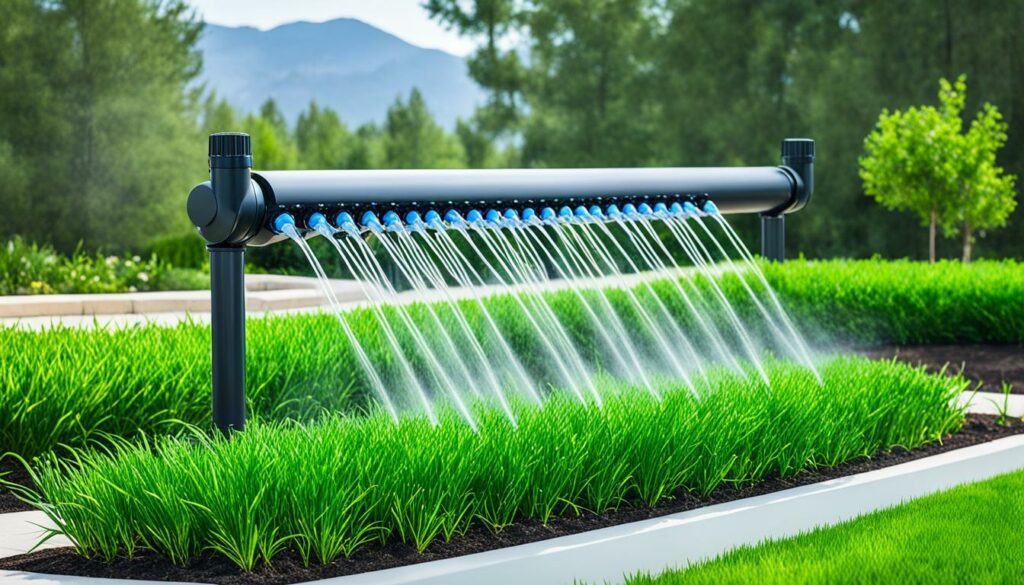
Imagine half the water at home goes to the garden. A good system design can cut this down. It does this by making sure water goes where it’s needed. It stops using water when it rains, thanks to special sensors. This saves water a lot.
Using solar power in an irrigation system is a great move for the planet. Solar power means we use less from the grid and save money. Solar panels and batteries keep the system working, even when there’s no power or in faraway places.
Solar solutions fit in with saving nature. They help lower power bills and protect the environment. Solar power matches the green practices of new irrigation ways.
For example, drip systems match the use of solar power. They use little water and are allowed during bans. With solar power, they create a very sustainable system. This is good for taking care of special plants, too.
To sum up, a well-designed watering system with solar works really well. It saves water and money. By planning well and using solar, we get a great irrigation system for any place.
| Component | Benefit |
|---|---|
| Drip Irrigation Systems | Precise water delivery, reduced water waste, exempt from hosepipe bans |
| Smart Irrigation Controllers | Adjusts water based on weather data, reduces waste |
| Rain Sensors | Stops watering after designated rainfall, conserves water |
| Solar Power Integration | Renewable energy source, reduces reliance on electric grid |
| System Layout Planning | Ensures optimal water coverage, minimises wastage |
Setting up automated irrigation is straightforward if you follow a plan. This guide helps you build such a system, ensuring your plants get the water they need without much effort.
To start, you’ll need some key items:
It’s crucial to place drippers right, based on soil type. For example, sandy soil works best with 2GPH drippers placed close together. Loamy soil thrives with 1GPH drippers. And, clay soil, which absorbs water slowly, does well with .5 or 1 GPH drippers with specific spacing.
Next, you’ll connect the electronic parts. Here’s how to do it:
Ditching the traditional sprinklers for a self-regulating system is a smart move. It saves water and keeps your plants healthier.
With all set up, plan to spend 3 to 4 days tweaking and testing to get the watering right. This step ensures you use water and plant health wisely.
| Soil Type | Recommended Drippers | Spacing |
|---|---|---|
| Sandy | 2GPH drippers | Closely spaced |
| Loamy | 1GPH drippers | Specific spacing |
| Clay | .5 GPH or 1 GPH drippers | Particular spacing |
To sum up, following these detailed steps guarantees a strong and efficient irrigation system. This method makes the setup easy, leading to a system that waters your plants just right without your constant monitoring.
This part explains how to program irrigation systems and set up automatic water timings. Knowing this makes your system work perfectly.
The first thing for irrigation system programming is adding the right code to Arduino. This tiny computer is the heart of your system. It should be coded to match how you want it to work, like when to water based on the soil’s moisture and the air’s heat.
Imagine you’re using a soil moisture sensor. It gives you data from 0 (very wet) to 1023 (very dry). By adding this data to the code, it can tell the water pump to start if the soil is too dry. You can also include an LM35 temperature sensor. It helps you fine-tune the water schedule by considering how hot or cold it is.
After uploading the code comes testing and finding any problems. Start by powering the Arduino with 5V and making sure everything is connected well. Place the moisture sensor in the soil to check how well it works. Connecting the right pins for components like the LCD, LEDs, and water pump is key.
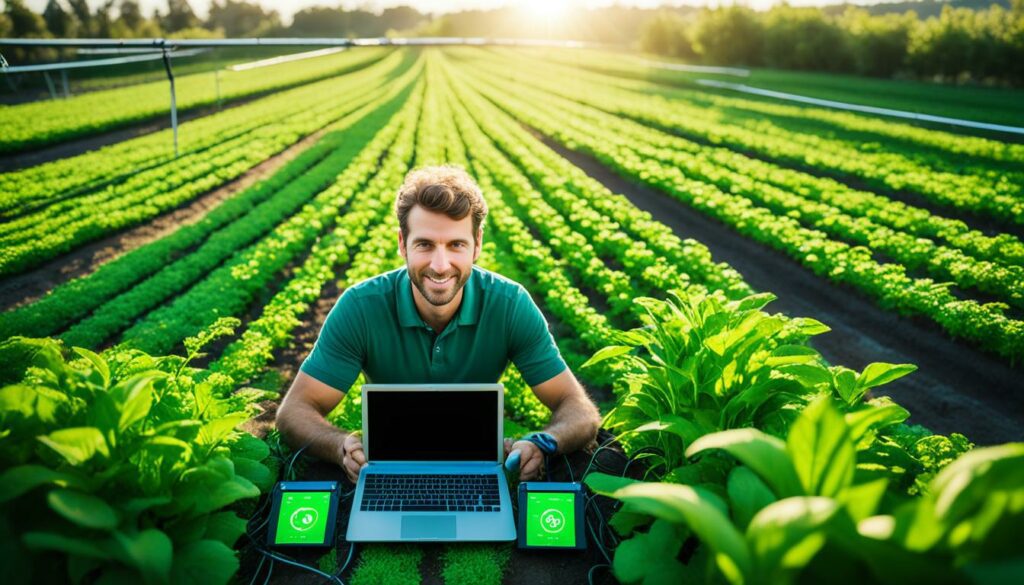
In tests, confirm that sensors and devices work together properly. For instance, there’s a way to calculate temperature from sensor data to make sure everything is in tune. You might also use a potentiometer to change the brightness of the LCD for better reading.
Spot issues early and fix them using irrigation diagnostic tools. These tools catch problems like wrong readings or bad connections, making sure your watering system works well.
| Component | Function | Pin Assignment |
|---|---|---|
| LCD Display | Monitor Sensor Data | Specific Pins (e.g., D2-D7) |
| Water Level Status LED | Indicate Water Level | Pin D8 |
| Speaker | Alert System Alarms | Pin D9 |
| Pump Status LED | Show Pump Activity | Pin D10 |
Solar power in irrigation is a big step forward in farming tech. It allows for big money and environmental savings. These systems use the sun’s energy to water fields, reducing the need for electricity from the grid. In the U.S., agriculture uses most of the country’s water and a lot of energy to pump it. So, using solar power helps the economy and the planet by saving on these resources.
Using the sun for irrigation has many pluses. It’s clean, reducing harm to our atmosphere. Solar is easy to find and can cut costs once installed. In Western States, farming uses a lot of water. So, switching to solar power is good for saving on water and energy. I installed a solar system powering a pump from the sun. It shows how well solar can handle big water needs.
Setting up a solar irrigation system needs key parts for good watering use. It uses solar panels, a storage battery, and smart tech to check soil wetness. My setup had powerful batteries to keep water going even when it’s dark. Sensors from Sensirion watched how wet the soil was.
A smart system controlled everything, saving water and energy. It used special tech from Arduino and XBee to watch and adjust the watering. This solar system is great for saving money and being kind to the earth.
Here’s a detailed comparison of energy and water usage in traditional vs solar-powered irrigation systems:
| System Type | Energy Usage | Water Efficiency |
|---|---|---|
| Traditional Irrigation | 15% of total energy annually | Variable, often less efficient |
| Solar-Powered Irrigation | Free energy post-installation | Optimised with sensors |
As farming methods change, there’s a big need for hi-tech irrigation solutions. By 2023, we saw big developments, like Colorado TAPS. This showed the best teams were both top producers and used nitrogen and water the most efficiently. The use of smart irrigation controls has given farmers better control and saved water.
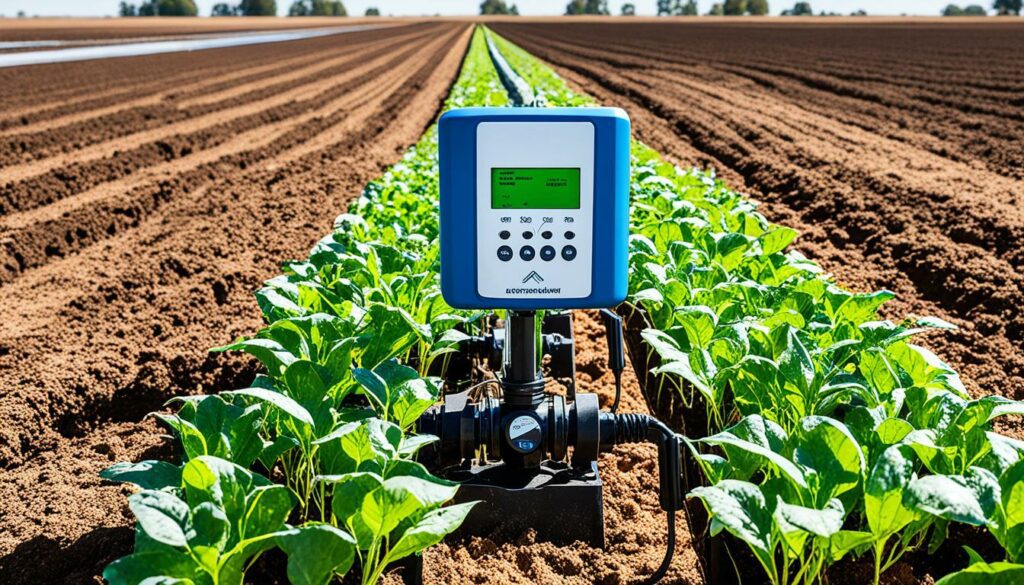
Under advanced moisture management, Variable Rate Irrigation (VRI) plays a big role. It uses GPS and soil sensors to adjust water as needed. This means water is applied carefully, reducing waste.
Monitoring soil moisture is crucial too. Systems that check moisture at different soil depths give up-to-the-minute data. Also, weather stations help predict the weather. This way, farmers can water their crops just as needed.
Remote sensing, via satellites and drones, can make irrigation even better. These tools provide lots of detailed info about the fields and crop health. Plus, governments help by giving out grants and loans for better irrigation tech, supporting water-saving efforts.
Smart irrigation controls such as WBIC and soil moisture-based controllers are essential. WBICs use weather and site details to tailor water use to what the plants need, stopping if it’s raining enough. Soil moisture-based controllers adjust water use based on how dry or wet the soil is, keeping plants just right.
Picking the right tech means looking at how accurate the weather info is and what kind of connection the tech needs. For example, to use WBIC effectively, you need controllers that can connect to Wi-Fi. And selecting the best soil moisture sensors means understanding how well they work and if they fit with your irrigation system.
| Feature | Description |
|---|---|
| Variable Rate Irrigation (VRI) | Uses GPS and soil sensors to vary water application. |
| Weather-Based Irrigation Controllers (WBIC) | Utilise weather/climate data to calculate evapotranspiration. |
| Soil Moisture Monitoring | Measures soil moisture at various depths in real-time. |
| Remote Sensing Technology | Employs satellites and drones for field condition monitoring. |
These advanced methods really help use water better, saving resources and boosting the harvest. By using hi-tech irrigation solutions, farmers can water smarter. This not only increases crop quality but also supports the good stewardship of our planet.
Precision irrigation technology is key for giving crops the perfect amount of water just when they need it. This method boosts how precise we are with irrigation. It cuts down on water and chemical use, helping both farms and the environment.
Precision in irrigation is very important. Systems that are precise can lower water use by 25%. This feature is vital for places that need to save water. By using the right amount of water, farmers can see an 8% increase in their harvests.
This technology also helps the environment. It cuts down on chemicals in the soil and stops water from running off fields. This keeps the land healthier for longer.
To make sure irrigation is accurate, many tools and tactics are used. For example, some systems can change water flow based on soil readings. This makes sure plants get just the right amount of water. Platforms like EOSDA use satellite data to show how much water plants need. Weather-based controllers are also key. They adjust to the day’s weather, making sure water is used wisely.
Though these methods are great, they might not work as well in sandy soil. That’s because sandy soil needs more water. The systems might struggle to give enough water in this case.
| Type of Precision Irrigation | Benefits | Challenges |
|---|---|---|
| Precision Surface Irrigation | Suitable for clay soils, varied techniques | High water volume needed for sandy soils |
| Precision Trickle (Drip) Systems | Reduces water volume, prevents weeds | Potential clogging and maintenance needed |
| Precision Mobile Drip Systems | Enhances delivery accuracy, reduces mist shifts | Higher initial investment costs |
Using advanced tools and methods greatly improves the efficiency of precision irrigation. This supports sustainable farming and helps reach the best crop yields.
Automatic watering systems help keep plants healthy while saving water. They use automated moisture control systems to check the soil’s moisture level. This way, plants get just the right amount of water.
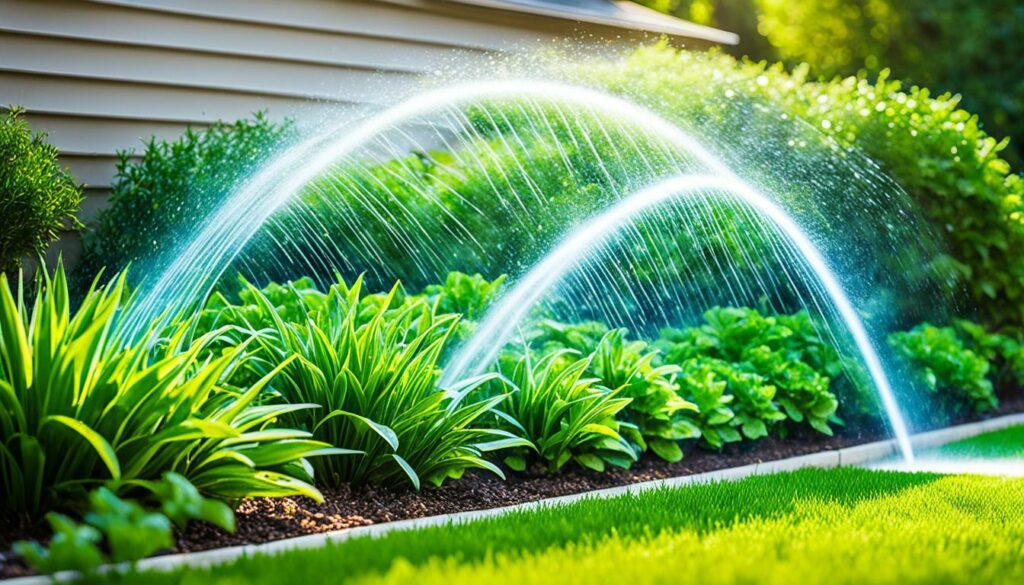
Setting watering schedules to fit each plant’s needs is key. Bespoke irrigation scheduling makes sure plants don’t get too much or too little water. The LetPot Smart Drip Irrigation System can handle up to 20 pots. It lets you adjust the water for different plants and soils. This means every plant gets the water it needs for proper growth.
Keeping an eye on soil moisture stops plants from getting too wet or dry. The LetPot Drip Irrigation System keeps tabs on moisture and is trusted by many. It uses the latest data to adjust watering in real time. This keeps your plants’ roots healthy and saves water. Plus, you can return it within 30 days if you’re not happy, and it has a 1-year guarantee.
Remote-controlled irrigation systems have changed the way we look after gardens. They use wireless technology to let us water our plants with ease. These systems can be set to water each part of your garden just right. So, you use water in the best possible way.
Take the Rachio 3 Smart Sprinkler Controller as an example. With several modes to choose from, it can water your plants at the perfect time. It saves water and money by changing its schedule according to the weather. This system can handle up to 32 zones and still work even if you lose Wi-Fi (though it won’t adjust the watering schedule based on the weather at that time).
Smart sprinkler timers are top in tests for their ability to save water. They do this by using less water than traditional timers. They can be controlled from a phone app and adjust to the weather. Yet, you can still tweak them by hand if you need to.
The B-hyve Smart Controller is another great system. It’s waterproof and uses local weather data to water your plants just enough. It can work with up to 126 zones and can be controlled by voice using Amazon Alexa or Google Assistant. This makes looking after your garden easy and smart.
| Feature | Rachio 3 | B-hyve |
|---|---|---|
| Zone Capacity | Up to 32 | Up to 126 |
| Modes | Fixed, Flex Monthly, Flex Daily | WeatherSense® |
| Voice Assistant Compatibility | Amazon Alexa, Google Home | Amazon Alexa, Google Assistant |
| WaterSense Certified | Yes | Yes |
| Weather-Based Scheduling | Yes | Yes |
Pairing these systems with your phone makes life easier. You can control your garden’s water from anywhere. This is perfect for big gardens or ones with lots of different areas that need watering. It shows how advanced technology can help us take better care of our environment.
The world’s population is growing fast, which means we’ll need more food. By 2050, we’ll need 70% more food to meet demand. This makes large-scale irrigation technology vital for efficient farming. These systems help farms use water better, grow more crops, and remain sustainable.
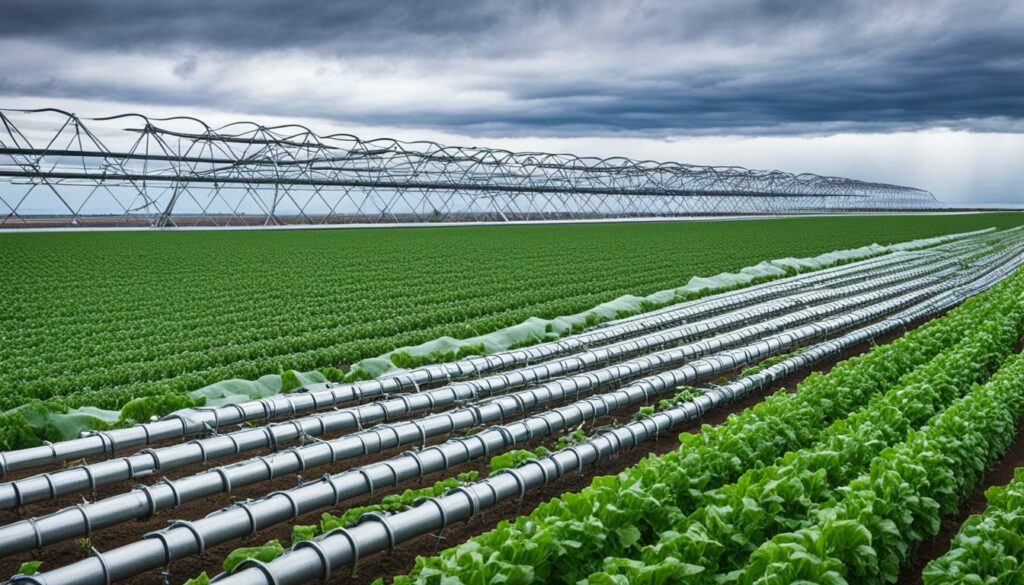
Adding agricultural irrigation tech to more areas is a big task. It means using IoT sensors for immediate soil, salt, and plant water data. Pioneering farming tech like automatic irrigators and RTK GPS boosts productivity and soil health. With water getting scarcer, these tools cut down water waste.
An in-depth look at costs and benefits is key for understanding irrigation tech’s value to big farms. This means weighing costs of setup and running against gains like saving water, growing better crops, and lower costs. The smart irrigation sector is expected to hit $2.1 billion by 2025. This shows growing confidence in its economic sense.
Moving to high-tech irrigation is a big step towards greener farming. Automated watering makes better use of water, cutting down waste. This helps farms make more money and use less energy. It also plays a part in feeding the world by tackling hunger for nearly 10% of people.
Many growers find that the cost to start automated irrigation systems is high. They must buy and set up parts such as controllers and sensors. This is especially a big expense for big farms with lots of irrigation areas.
Fixing problems with automated watering can also be hard. These systems have many parts like electronics and moving pieces. A lot of knowledge is needed to solve issues like sensor faults and connection problems quickly. This can be tough to learn, especially for anyone new to digital tools.
Making these systems work at their best is not easy either. They need constant checks and changes. Things like weather shifts and plant water needs must be met well. Getting the water settings right and keeping the parts in tune are key. This makes sure the systems use water and other resources smartly without harming crops.
Still, the benefits of using these systems are great. Large farms and those with many fields can save a lot of money and water with full automation. Less work is needed, water is saved, crops do better, and more crops can be grown.
Yet, small farmers or those growing forgiving plants might not see the point in going automated. If they have poor water systems or don’t aim to grow more, the cost might not be worth the gain.
Systems built with full automation in mind, though, can be easy and cheaper. They lower disease risks, boost crop quality, and cut waste cleaning costs. The tech industry is always making these systems better. AI and the Internet of Things help make farming water-wise and sustainable.
| Challenge | Solution | Benefit |
|---|---|---|
| Initial financial investment | Government incentives and subsidies | Reduced setup costs, increased adoption |
| Technical troubleshooting | Technical support and training | Minimised downtime, optimal system performance |
| System optimisation | Regular monitoring and adaptable scheduling | Efficient resource use, improved crop health |
In conclusion, automatic irrigation is a huge step towards sustainable watering. It brings many benefits like saving on work costs and watering plants when they most need. It’s better than doing it by hand as it’s more accurate and can deal with more water faster. These systems help use water and nutrients better, cutting down on waste and lower costs to operate. They lead to healthier plants and better crops.
But, there are challenges too. Setting up these systems first costs a lot of money. They might not work perfectly if not set up right. And, they’ll also need more upkeep. Yet, they save money and are more efficient over time. This makes the downsides less important.
The future of farming tech is closely connected to smart watering solutions. There are different types, from simple timers to advanced SCADA systems. The trends are moving towards using AI and internet tech to manage water even better. This could really boost plant growth. Smart watering not only helps the environment, but it also keeps farms profitable.
These systems use technology to water plants without needing you to do it. They figure out how much water each plant needs. This saves water and keeps plants healthy and strong.
Digital systems decide when and how much to water plants automatically. They make sure plants get just enough water. This reduces water waste and helps save the environment.
This technology makes sure water is used wisely to grow plants. It only waters where it’s needed. This saves water and helps plants grow better.
They include a smart computer called Arduino Uno, sensors to check soil moisture, and valves to control water. Also, there are special tubes and parts to water plants right at their roots.
First, you plan where to put sensors and water lines. Then, you add solar power for sustainability. This leads to a smart water system that looks after the plants on its own.
First, get the right parts like controllers and valves. Then, connect them using a guide. This guide helps you put everything together correctly.
You program the software and set it up to water the plants on time. After setting it up, you check if everything works smoothly. This makes sure your smart watering system is working well.
They use sunlight instead of electricity, which saves money. These systems have solar panels and batteries. They help water the plants without harming the planet.
The newest technology in watering includes smart sensors and controllers. They water plants only when it’s really needed. This saves water and helps plants grow better.
Being precise means giving plants exactly the water they need, not too much or too little. Use of hi-tech tools helps in better water management. This keeps plants healthy and saves water.
They check how moist the soil is and water plants just right. With real-time data, they make sure the soil stays just as plants like it, using water wisely.
These are sprinklers you can control with a mobile app from anywhere. They’re great for big areas or lots of plants. They bring ease and control to watering.
Before using the latest water tech, farms should check if it saves water and increases crop yields. This helps decide if it’s worth the investment and ensures the farm is well-watered.
Setting these systems up costs money and they might have technical issues. Keeping them running smoothly takes effort. Yet, the benefits for the environment and the plants are big.